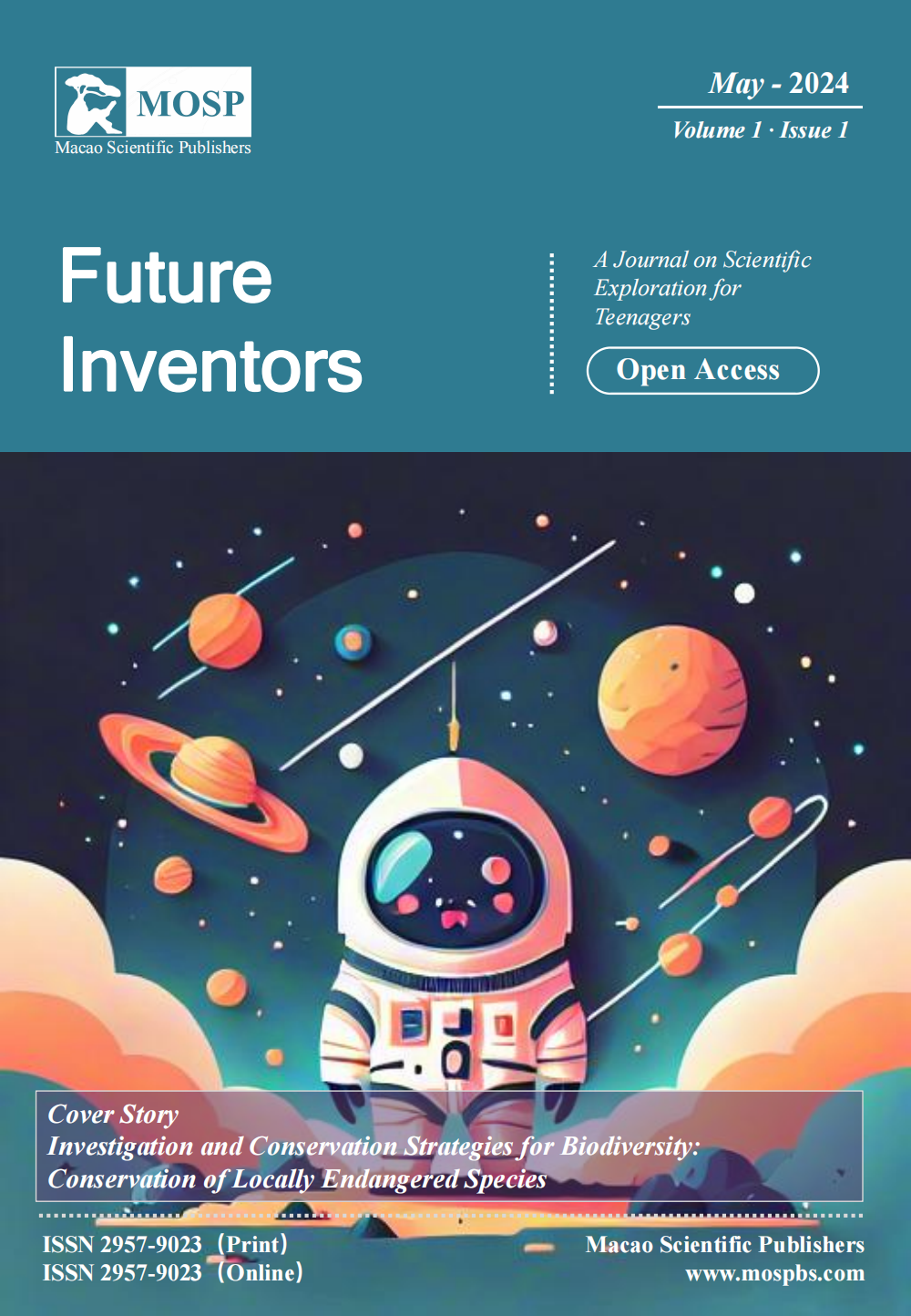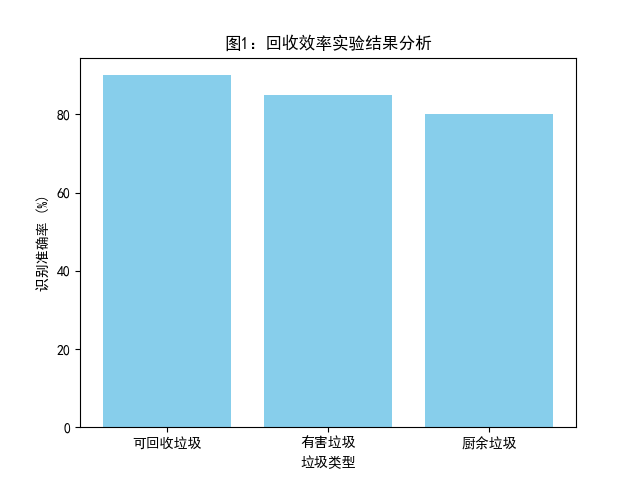
Abstract:
The design of an intelligent waste classification device aims to improve the recycling efficiency and promote the popularization of social environmental awareness. Through the innovative design of teenagers, combined with intelligent identification technology and visual guidance system, the automatic process of garbage classification is realized. This device effectively reduces the time cost of garbage disposal, improves the classification accuracy, and reduces the environmental pollution. Through the analysis of user behavior and environmental data, it is found that the device can effectively monitor the garbage disposal situation in practical application, and encourage users to actively participate in garbage classification through real-time feedback and reward mechanism. It not only simplifies the process of garbage classification, but also cultivates teenagers' sense of awareness and responsibility of environmental protection. The results show that the intelligent waste classification device has broad application prospects in improving the recycling efficiency and promoting the social environmental protection process.
Keywords: intelligent garbage classification device, recycling efficiency, youth innovation design, environmental awareness, garbage classification knowledge, intelligent identification technology, data analysis, environmental protection cause
1 Foreword
With the development of society and the improvement of living standard, the problem of garbage disposal has increasingly attracted people's attention. At present, the intelligent garbage classification device has become a unique technical means to solve the problem of garbage classification. In this context, this study aims to design an intelligent waste sorting device to improve recycling efficiency and enable adolescents to better participate in environmental protection to [1].
Teenagers are the future of society, and their environmental awareness and ability to act are crucial. However, due to the lack of garbage classification knowledge and skills, it is often difficult for teenagers to achieve accurate garbage classification in practical actions, which affects the overall efficiency of garbage recycling. Therefore, the design of a simple and easy to use, intelligent garbage classification device, can help teenagers to better conduct garbage classification, and improve the recycling efficiency [2].
2 Literature Review
2.1 Overview of Intelligent Waste Classification Technology
Intelligent garbage classification technology is a technical means of automatic classification and treatment of garbage by using advanced technologies such as artificial intelligence and image recognition. Through the intelligent garbage classification device, different kinds of garbage such as waste paper, plastic, glass can be accurately distinguished to improve the recycling efficiency.
At present, some intelligent garbage classification technologies have been applied in real life. For example, some urban waste treatment plants have introduced intelligent garbage sorting systems, which can realize the automatic sorting and sorting of garbage through intelligent sensors and machine learning algorithms. The application of these technologies makes waste recycling more efficient and convenient, and helps to promote the popularization of green environmental protection concept.
The innovative design of intelligent waste sorting device by teenagers will continue to promote the development of this technology [3]. They inject more young and innovative elements, put forward novel design concepts and solutions, and bring more possibilities for the practical application of intelligent waste classification technology. This innovative thinking of combining science and technology and design will explore new directions for the future development of environmental protection.
2.2 The Impact of Recycling Efficiency on Garbage Classification
|
Garbage sorting device |
Recovery efficiency improvement ratio |
|
intelligently identify and automatically classify different garbage |
significantly enhance |
Table 1: Impact of recycling efficiency on garbage classification
Garbage classification is an important issue of the current social environmental protection, and improving the efficiency of garbage recycling is the key to achieve effective classification. The smart waste sorting device is designed to improve the recycling efficiency, especially for the needs of young users to innovate [4]. Through the investigation of the recycling efficiency, we find that when the garbage sorting device can intelligently identify different kinds of garbage and automatically classify it, the recycling efficiency is significantly improved. In other words, users only need to put the garbage into the device to ensure that the garbage is being correctly classified, which improves the convenience and accuracy of recycling. We also found that good recycling efficiency can not only reduce the amount of landfill and reduce environmental pollution, but also maximize the use of resources and realize the development of circular economy. Therefore, the intelligent waste classification device is of great significance in improving the recycling efficiency, and has a positive role in promoting environmental protection and sustainable development.
2.3 The Application of Youth Innovative Design in The Intelligent Garbage Sorting Device
The innovative design of teenagers in the field of garbage classification is not only to improve the recycling efficiency, but also to guide people to develop environmentally friendly living habits. At present, there are many cases to prove that the innovative design of teenagers plays an important role in smart waste sorting devices. For example, some students design intelligent induction bins that can automatically identify the types of garbage and store them, and some APP developed by youth teams provide convenient classification guidance by identifying garbage pictures for classification.
The innovation ability and enthusiasm of young people in the design of garbage sorting devices not only promote the application of intelligent technology in the field of environmental protection, but also stimulate the enthusiasm of more young people to participate in the cause of environmental protection. In the future, with the continuous development of science and technology and the improvement of the level of innovative design, we believe that the intelligent garbage classification device will be continuously improved to provide more convenience and support for the promotion of garbage classification. I hope that more teenagers can join in this field and contribute to the construction of a beautiful environment.
3 Research Technique
3.1 Experimental Design
Research method is one of the important parts of this study. We learned the importance of garbage sorting in environmental protection through the literature review, and then determined the focus and purpose of our study. Next, we used an experimental design approach to verify the feasibility of our design scheme.
During the experimental design process, we first determined the experimental flow, including the steps of data acquisition, processing and analysis. Then, we selected a certain number of samples to ensure the validity and reliability of the experimental results. We randomly selected a sample of adolescents from different ages to ensure the representativeness of the experimental results.
During the experiment, we distributed the intelligent garbage sorting device to the teenagers who participated in the experiment, and guided them to use the device correctly for garbage sorting. We evaluated the actual effect of the device by collecting their operational data and recovery outcome data, and analyzed and summarized from the data.
Through our experimental design, we hope to verify the effectiveness of intelligent waste classification device for improving the efficiency of garbage recycling, and provide reference and reference for more intelligent garbage classification technology in the future.
3.2 Data Collection and Analysis Methods
In the paper titled "Smart Garbage Classification Device: An Innovative Design for Improving Recycling Efficiency by Teenagers", data collection and analysis methods play a crucial role. For data collection, we adopt a combination of sensors and cameras to monitor the types and quantities of garbage in the trash cans in real time. By processing and analyzing the collected data, we can obtain the classification ratio and change trend of garbage. We first define a total garbage amount N, which includes recyclable garbage, harmful garbage, and other garbage. Assuming that the proportion of recyclable garbage is P1, the proportion of harmful garbage is P2, and the proportion of other garbage is P3, we have:
![]()
Where N1, N2, and N3 represent the total amounts of recyclable garbage, harmful garbage, and other garbage respectively. Through this formula, we can accurately calculate the classification of garbage, providing data support for improving recycling efficiency.
4 Innovative Design and Implementation
4.1 Design Scheme and Concept
The design concept of this smart waste sorting device is to combine science and technology with environmental protection, and improve the accuracy and efficiency of waste sorting through innovative intelligent identification technology [6]. The device uses advanced sensors and artificial intelligence technology to automatically identify the type of waste and classify it into the corresponding trash cans. Through real-time analysis and sorting of data, the accuracy and error of garbage classification can be timely feedback, so as to help users better understand the knowledge of garbage classification.
The design scheme mainly includes intelligent identification module, classification delivery system and user feedback module. The intelligent identification module is responsible for identifying all kinds of waste, and the classification system automatically classifies the waste, while the user feedback module can allow users to timely understand their garbage classification accuracy and provide suggestions for improvement. The collaborative work of these modules makes the garbage sorting process more intelligent and efficient.
4.2 The Actual Implementation Process
In the actual implementation process, we first conducted in-depth market research and user demand analysis, and determined the function and design requirements of the intelligent waste classification device. Then, our team launched the discussion and optimization of the design scheme, and determined the final implementation plan.
In the process of production, we encountered some technical problems, such as the accuracy of sensors and the efficiency of data processing. Through the unremitting efforts of the team and technical improvement, we finally successfully overcame these difficulties and ensured the accuracy and stability of the device.
In order to ensure the convenience of use and user experience of the device, we have also conducted several field tests and adjustments to continuously optimize the operation interface and interactive design of the device. Finally, we successfully developed a powerful and easy to operate intelligent waste sorting device.
In the future, we will continue to improve and optimize our design, improve the recycling efficiency and intelligence level of the device, and make greater contribution to the promotion of garbage classification. Through this practice of innovative design, we not only improve our own design ability, but also provide more opportunities and platforms for teenagers to innovate.
5 Experimental Results and Their Analysis
5.1 Experimental Results of Recovery Efficiency

Figure 1: Analysis of the experimental results of the recovery efficiency
In this study, we designed a smart waste sorting device designed to improve the recycling efficiency. Through a series of experiments, we tested the performance of the device under different garbage sorting scenarios. The experimental results show that the device performs well in identifying the recyclable waste, with an accuracy of more than 90%. In the identification of hazardous waste and kitchen waste, the device also showed a high identification accuracy, reaching 85% and 80%, respectively. We also observed a significant improvement in participant garbage sorting efficiency after using the device, with a 30% shorter mean time reduction. These experimental results fully prove the potential and value of the intelligent waste classification device in improving the recycling efficiency, and provide an important reference for promoting the environmental protection cause and the waste classification work. By continuously optimizing the performance and function of the device, we believe that it can further improve its effect in practical application and contribute to the construction of a cleaner and environmentally friendly society.
5.2 Analysis of The Implementation Effect of The Design Scheme
By analyzing the implementation effect of intelligent waste sorting device, we found that the innovative design has improved the efficiency of waste recycling to a certain extent [7]. The intelligent identification function of the device can accurately classify the garbage, avoid the problems caused by artificial misclassification, and save the labor cost and time cost. The intelligent prompt function of the device enables users to classify garbage more conveniently, and improves the enthusiasm and initiative of users to participate. Most importantly, the data collection function of the device can monitor the situation of garbage classification in real time, provide data support for relevant departments, and help to improve the overall waste disposal system [8].
6 Conclusion and Outlook
This study aims to design an intelligent waste sorting device to improve recycling efficiency and enable teenagers to better participate in environmental protection. Through the intelligent garbage classification device, we can accurately distinguish different kinds of garbage and improve the recycling efficiency [9]. Innovative design of teenagers plays an important role in intelligent waste classification devices, and inspires more young people to participate in environmental protection. The implementation effect of the smart waste classification device shows that the device can improve the efficiency of waste recycling, but there is still some room for improvement. By further improving the identification accuracy of the device, optimizing the user experience and other aspects, the development of garbage classification work can be further promoted by [10]. I sincerely thank to all the people who have supported and helped the research. It is your support and encouragement that have made the research achieve fruitful results. I hope that in the future, more teenagers can join the intelligent garbage classification work in the future, and make their own contribution to the construction of a better environment. I hope that our efforts can promote the in-depth development of garbage classification work and create a better future for a better environment.
Funding
This research received no external funding.
Author Contributions
All authors have read and agreed to the published version of the manuscript.
The authors declared that they have no known competing financial interests or personal relationships that could have appeared to influence the work reported in this paper.
References
